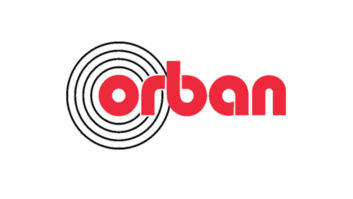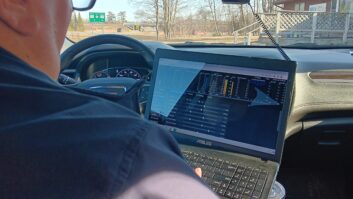In 1975 Bob Orban came along with a single device, the Optimod-FM 8000, encompassing audio processing, peak limiting and stereo generation, which permitted optimization and matching of each component of an FM processing chain, from AGC to protective clipping to stereo generation. It produced a louder signal with fewer artifacts while maintaining superior stereo performance.
The quest for FM perfection has continued, first in the analog domain and later with algorithms and digital signal processing capable of greater precision and stability. The field is quite competitive, with several manufacturers in the U.S. and abroad offering many models of software-defined audio processors. On-air processing continues to be a learning curve for manufacturer and broadcast engineer alike.

Each processor has personality of its own: a sound signature, a user interface that may be more or less intuitive, greater or fewer tuning options, etc. Each GUI is sufficiently different to require some familiarization with what the settings really do sonically.
Evolution
Sophisticated audio processors continuously adapt to the audio content as its texture changes in real time. This makes it difficult to get the right sound for everything in one sitting. Popular music recordings vary wildly in spectral content and studio processing. In fact a lot of contemporary music has some distortion, which can be magnified by even mildly aggressive processing.
Manufactures have learned to fight back with clever solutions including speech detection, separate voice processing settings and even distortion masking and repairing, rounding off clipped audio coming in from the source material.
Optimods just keep getting better. Several years ago I standardized one of Saga Communications’ clusters with three Optimod 8500s. Firmware varied from an early version in the first box I bought to relatively newer firmware in the later two. I found the most aggressive presets sounded too distorted for my taste on most material. I always had to dial them down, to the chagrin of the PD, who liked a lot of punch. I recently had the opportunity to upgrade the firmware in my oldest 8500 and was pleasantly surprise to find it handling aggressive audio better.
Curb Appeal
The new Optimod-FM 8600 is a definite notch above Orban’s earlier products.
When I unpacked this unit I noticed the striking glossy ebony paint of the front panel and rack ears. The finish is as classy-looking as a grand piano’s. The rest of the chassis is Orban’s usual zinc-plated steel, great for reducing interference from magnetically-induced noise sources.

Orban Optimods are shown at work in the author’s transmitter room. An Optimod-FM 8500 is visible in the middle rack, with the 8600 below it.
This 8600 was manufactured in Germany.Outsourcing manufacturing off of our shores seems to be a fact of life these days. Orban tells Radio World that this demo unit was review stock, and that U.S. buyers receive units made in the United States. German-made stock will be sold to overseas buyers.
It came with two EIA power cords, one with North American blades, the other with a European power source plug. The unit could default to 240 VAC, requiring you to switch the AC input voltage selector to 120 VAC and change the line fuse to twice the ampacity to compensate. This is common among audio processor hardware manufacturers. The box arrives set for the highest AC voltage, so that a purchaser who forgets to read the manual and plugs into a 240 V mains won’t damage it.
My demo unit came set for North American power. I would have preferred a wide-range auto voltage switching power supply to eliminate the danger of plugging it into the wrong mains supply voltage.
After bench-testing an 8600 with an exciter, I moved it up to the tower site of my FM flamethrower and put it into the air chain.
I prefer to place my FM audio processor at the tower site to achieve best results. Anything else between the composite output of a modern processor and the exciter is a compromise, even if it is digital. Let the magic DSP-generated composite signal created by your expensive box do the heavy lifting for FM modulation.
One of the hot presets, called Impact, I could not use with my older 8500 because it sounded too harsh. However, I was able to use the new Impact MX version with the new 8600 as it sounded much cleaner.
Special new versions of some factory presets are labeled MX, which, according to Orban, indicates MaXimum performance. These add an additional quarter-second processing delay, which would not be viable for live on-the-air monitoring but is fine for stations that have long given up live monitoring due to the eight-second diversity delay required for the iBiquity HD Radio standard.
A lot of new magic happens during that 270 millisecond delay. The processor uses a lookahead audio buffer to give it time to study a larger sample of audio to better decide how to tame it to prevent peak limiting distortion, especially with bass-heavy material. This is not a subtle enhancement.
The 8600’s pre-emphasis limiter yields less audible distortion while providing 2.5 dB more highs than its predecessor. It is a departure from the 8500 as it uses psychoacoustic modeling to help reduce distortion while improving transient response. This has enabled Orban to achieve high-frequency response parity with source material in spite of the pre-emphasis curve over-modulation protection requirement.

8600 Set-up Screen
Other features include a two-band compressor structure that can be phase linear for audiophile radio station formats. Diversity delay comes standard with up to 16 seconds available to cope with newer IBOC gear requiring a delay greater than 8 seconds to line up analog with digital audio.
There is a low-delay monitor output you can set up to provide a simulation of on-air audio for your control room talent if your Optimod is at the studio. And there is a novel new experimental mode for the stereo generator providing a single sideband version of the 38 kHz L–R carrier, which results in even less interference with SCAs while being transparent to most receivers’ multiplex decoders.
DSP is clocked at 64 kHz internally so that the output of the sample rate converters can be safely used at 32 kHz through 48 kHz without worrying about overshoot.
Installation
First introduced in the Optimod 8400, an improved DSP composite limiter uses Orban’s patented half-cosine algorithm. It can be driven hard to get a little more loudness, but with the inevitable tradeoff of more clipping distortion on some material.
The compressor/limiters of prior stages do a superb job providing ample loudness. It is best to let those stages do the heavy lifting and go light on composite limiting.
The 8600 uses the same size color LCD display, joystick, spinner wheel and enter buttons as the 8500. It is TCP/IP-centric and can be programmed and controlled remotely via a network connection. It still comes with RS-232 serial port control, making it compatible with earlier Optimod installations. If you have additional subcarriers or RDS you can connect them to inputs on the 8600 where they’ll be mixed with the composite output without requiring external BNC tees or composite DAs.
Preset modify has three levels: Basic, Intermediate and Advanced. Many of the 8600’s presets can be used as is, with the basic less/more control to adjust them to taste. You needn’t be an expert off the bat. As time permits, you can delve into the more advanced modes and play with, tweak and store your customized presets.
The 8600 can accept up to eight GPI contact closures for remote stereo mono control, to change presets, turn off and on diversity audio delay or a host of other functions. In addition it has two tally outputs that can be programmed to report if analog or digital audio sources have gone silent. The 8600 will auto switch to an alternate audio source if so desired.
Since this is a digital device, care must be exercised in the peak analog audio level you present to it. If you overdrive the analog-to-digital converter, you will cause clipping distortion at the get-go. Unlike the old days of VU meters it is important to observe the actual peak audio voltage levels rather than average power levels.
Setup is easy but may require you to watch the levels over many hours and many board operators to be sure you’re maintaining sufficient headroom. Conversely, you don’t want to set the incoming level too low as it will increase the noise from the analog input stage and quantizing noise from the converter. There is a sweet spot and the input bar graph makes it fairly easy to hit. The input level control is well-named, “Clip Level” control.
The 8600 incorporates a frequency-agile set-up tone generator. It can be used to calibrate to your exciter’s input if you don’t mind putting tones on the air. I usually use normal program material. If you set the pilot injection level to be the same for either the 8500 or 8600, you can use it as a reference to match up composite output levels.
The HD Radio processing chain in the 8600 can be adjusted for independent compression and equalization including a de-essing function to roll off high frequencies a tad, if one desires, to prevent the HD side from sounding brittle.
Processing power
For golden ears you can independently flip the phase of the analog outputs and/or the HD outputs. Thus you can compensate for phase reversals between your FM and HD signals for better blending when an HD receiver switches between digital and analog fall-back and also to correct for absolute phase difference in your air chain. Some folks claim they can hear whether their speakers are pulling instead of pushing on what should be an air compression of the original audio.
The analog diversity delay adjustment menu item in the 8600 has three settings, coarse, medium and fine, rather than only two. Having the medium dial rate makes it much easier to tweak in the right amount of delay by ear. On a good day I can get to within two AES samples without resorting to an HD modulation monitor which might require up to a minute for each timing check.
You might wonder why audio processor improvements are not applied to previous models, perhaps offered as a software upgrade for a fee. The answer is simple. There is only so much you can do with the horsepower under the hood.
Product Capsule
Orban Optimod-FM 8600 Digital Audio Processor
Plus
+ Easy to set up with intelligent menus and excellent user interface
+ Sounds even better than previous models, can play louder, punchier and cleaner
+ Can be dropped in place of an 8500 as I/O is identical
Minus
– Increased latency
– Power supply requires voltage switch, room for errors
– Comes with two power cords, a waste of resources
Price: HD Digital – $13,990; FM Digital – $10,990
For information, contact David Rusch at Orban in Arizona at (480) 403-8300 or visit www.orban.com.
DSP requires a huge amount of number-crunching power. As chips become faster and less power hungry, the opportunity to add more coding tricks becomes more feasible.
The power supply in the 8600 is identical to that in the 8500, but it runs a bit cooler as the DSP board in the 8600 is more energy efficient.
Under the hood you will find the same dual architecture design as the 8500. One CPU is dedicated to control and supervision, operates the LCD display, monitors the switches, etc. The DSP board can run independently so audio processing, once initiated, will continue to function even during a software upgrade. The mission-critical DSP board soldiers on even if the control CPU falters.
The 8500’s DSP board used 12 Freescale 150 MHz chips while the new 8600 uses only nine, more powerful, Freescale 250 MHz dual-core chips. The net result is approximately three times the processing performance.
This is Orban’s cleanest Optimod yet. The final FM processing is better-sounding at similar loudness levels than its previous flagship processor. The sound is a bit more consistent with differing content.
I find that, like its predecessors, it is an easier box to set up and tune to your audio pallet than other brands. And it does permit your FM to sound a bit more like your HD audio.
But it achieves its goals with one drawback, increased latency, which makes it harder for on-air personality to monitor actual air product. You also have to wonder if the high cost of the product is worth the incremental improvement in an era where the average listener accepts the limited quality of low-bitrate streaming audio as perfectly acceptable.
For the few days I had the 8600 on the air, my PD had a wide grin. He loved the sound. He was a little disappointed when the day came to part with it.





